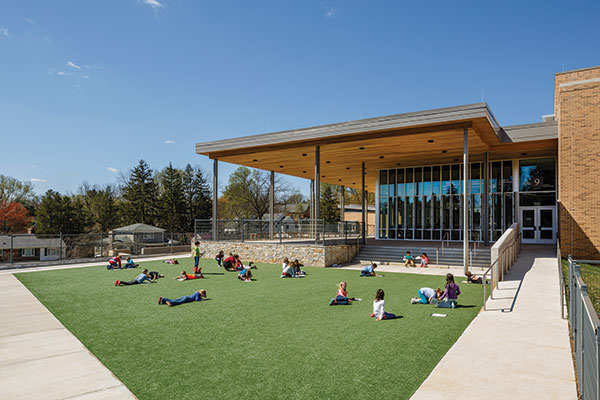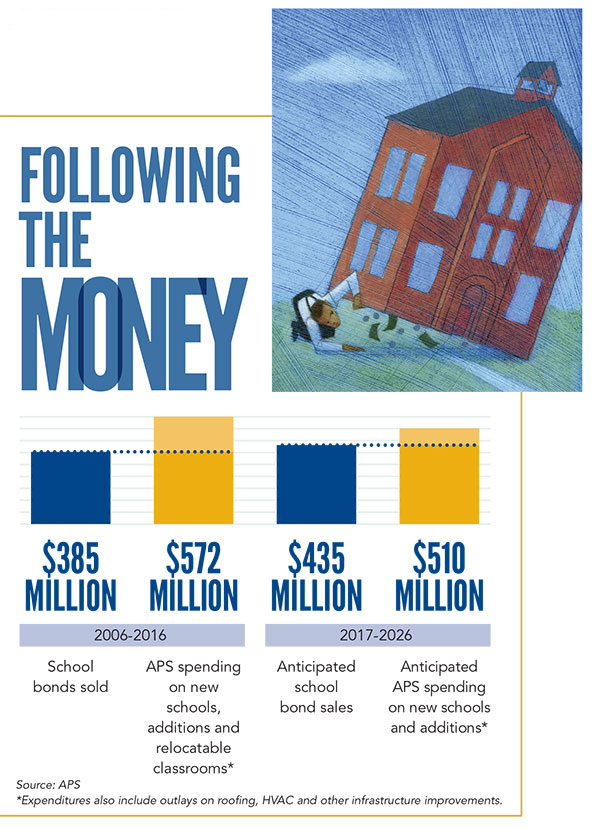There is yet another way that APS could maximize space and save money without incurring added construction costs. It could jack up class sizes, which currently average about 20 students per class, regardless of grade level. (By comparison, Fairfax County classrooms average 22 students per elementary class and 26 per high school class, according to the latest WABE survey.)
But in a county where academics are a point of pride and seven in 10 adults have a college degree, some fear that such measures would strip APS of one of its greatest strengths. “I feel like we’re really lucky in Arlington to have smaller class sizes than almost anyone around us,” says petition organizer O’Such. “That’s one of the reasons we stayed here after our child was born.”

Arlington’s state-of-the-art Discovery Elementary School (here and below)
Which brings us to the time-consuming tradition of community engagement known as The Arlington Way. When it works, this democratic process results in much-needed school and civic improvements, such as the long-overdue renovations and small addition that are currently underway at Abingdon Elementary. That project was greenlighted partly in response to advocacy efforts by school parents and other community members.
At the same time, Arlington’s town-hall tradition—which allows any and all community members to have their say—also has been known to pad new buildings with pricey features and drag out construction timetables. Since labor and material costs typically rise over time, delays can be expensive. Plus, architects and engineering consultants often participate in the dozens of stakeholder meetings that each major project requires, and paying for that billable time can cost APS upwards of $1,750 or more per meeting, Chadwick says.

School officials are pondering what they call “non-capital” options to mitigate the capacity crunch—such as getting more mileage out of existing school buildings with split student shifts, increasing online learning opportunities (which some academics see as the wave of the future) and building internships into the curriculum. “From 30,000 feet, our problems look less like an overall capacity problem and more like a scheduling bottleneck,” stated one recent task force in its report to Superintendent Patrick Murphy.
However, proposed measures like these are already stirring community opposition as APS embarks on a “visioning process” that will update how high-schoolers are educated.

County officials realize they may eventually need to explore new funding mechanisms for schools. A few years ago, APS commissioned a 300-page report by the real estate consulting firm Meany & Oliver, with recommendations for weathering brisk growth. The study, completed in 2011, urged Arlington leaders to augment school construction funding, catalogued 865 potential sites for new schools, and outlined an action plan to spur the creation of thousands of new seats. (Though the report was never made public, APS provided a copy to Arlington Magazine upon request.)
Among its recommendations, the report suggested that Arlington establish “a tax-favored foundation” and seek donations. It also recommended collecting fees from housing developers to help defray the costs of school construction. (While the Commonwealth of Virginia has always restricted the scope of such arrangements, known as “school proffers,” Fairfax, Prince William and Loudoun counties managed to raise some $84 million between 2002 and 2010 using this approach, according to the report.)
All told, the Arlington County government could be facing some tough decisions in the near term—such as reducing spending on parks and affordable housing to free up education dollars. “There may need to be some hard choices and trade-offs in the future that we so far have managed to avoid,” Vihstadt says.
Arlington is not alone in its struggle to pay for school growth. A recent report from the National Council on School Facilities and three other groups finds that school districts nationwide spend $46 billion per year less than they should to maintain and expand infrastructure.
At the same time, Arlington does not qualify for the scant federal funding that’s earmarked for less affluent school districts. And it doesn’t get much assistance from the Commonwealth, partly because Virginia has proven to be less inclined than other states to kick in funding for school construction projects. Since 2006, Richmond has provided only $1.7 million for school construction in Arlington, notes Leslie Peterson, who now serves as APS finance director after several years as its budget director.
As APS runs out of space in its budget to shoulder additional debt service, Arlington County has little room of its own to spare. Debt service will consume at least 9.6 percent of the county’s total budget between 2021 and 2025, according to its current $3.3 billion 10-year construction plan, which includes APS expenditures.
That means Arlington eventually may need an alternative to school bonds to pay for additional school seats. “Basically there would be two choices, either together or separately. And that would be to either raise taxes or cut spending,” Vihstadt says. “Neither of those options is particularly attractive.”
School officials are optimistic that student enrollment will start to level off 10 years from now. But if—worst case—the rapid growth continues, APS could be short another 4,000 seats or more, according to its own projections. That’s the equivalent of at least three more schools, which would cost at least $300 million in total to build, not including the cost of new land or structured parking. In that event, “unless we’re prepared to make cuts elsewhere, additional taxes will be required,” says County Manager Mark Schwartz.
Would Arlington flinch if higher taxes were put in place? Noah Simon, the former school board member, doesn’t think so.
“If there were a need for a big tax increase because of the schools being in dire straits, it would be strongly considered,” he says. “I have yet to see a school need that has not been met.”
Emily Schwartz Greco lives in Arlington, where her children attend Claremont Immersion School. She spent more than two years as an advocate representing the Claremont neighborhood on school capacity issues before switching gears and authoring this article.


Numbers in this article have been rounded for clarity.
